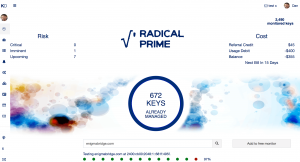The API functions use authorization keys, but we use them to manage access control. It means clients can generate their own, or receive a new API key on the fly from the KeyChest server.

It means you don’t need to do any personalization for new clients and integrations can be built into the images, dockers you use to spawn new virtual machines or into simple wrappers for Let’s Encrypt clients.
What does this integration give you? There are several advantages:
- We link all API keys and your clients via an email address they provide; which means you can see expirations, configuration problems, and so on in one view in the KeyChest web interface.
- You can start using a new email address without registering an account – we treat such email addresses as unverified, which means we only start monitoring your servers, if we detect a relevant certificate shortly after it’s been enrolled via our API.
- You get monitoring data from “user’s point of view”, i.e., whether their browsers will verify your servers as secure. This provides a real end-to-end validation of your server, ISP, and network configuration.
The API Logic
There are three types of calls, and three steps, you need to implement for full integration:
- Step 1: Claim API key – one-off call, where your client requests its own unique API key (we need to make sure this API key is unique). There are two versions – POST and GET. The difference is whether the client generates its own API key (POST) or KeyChest creates one and sends it back.
- Step 2: Add server – submit a domain name for monitoring.
- Step 3: Check expiration – check whether a certificate needs to be renewed. This is an optional call, which provides your code with data for e.g., triggering certbot renewal.
We recommend the client keeps two pieces of information as its state. The first item is its API key. The second is a timestamp of its last execution, which can be compared against “last scan” timestamps returned by the “Check expiration” API call.
If you’re interested in more details, please have a look further down, or at our online documentation: https://api.enigmabridge.com/api
Examples using curl
Step 1: get an API key
curl https://keychest.net/api/v1.0/access/claim/[email protected]
If you are familiar with jq, you can get a new API key with the following command:
curl -s https://keychest.net/api/v1.0/access/claim/[email protected] | jq -r '.api_key'
Step 2: register for monitoring
curl -s -X POST -H "Content-Type: application/json" -d '{"api_key":"5b9b6aceb95011e7bb9f7fca73a26228", "domain":"fish.enigmabridge.com"}' https://keychest.net/api/v1.0/servers/add
Step 3: check expiration
curl -s https://keychest.net/api/v1.0/servers/expiration/fish.enigmabridge.com?api_key=da70d5e4864f57e910e66bd21c685b26
List of basic API functions
| Register/check API key |
|---|
| GET request – The client requests KeyChest to generate an API key for a user account identified with the email. |
Requesthttps://keychest.net/api/v1.0/access/claim/[email protected] |
Response
{
"status": "created",
"user": "[email protected]",
"api_key": "5b9b6aceb95011e7bb9f7fca73a26228"
}
|
| Notes email – a mandatory parameter, it will be used to access an existing account, or to create a new account.A successful response returns the “status” value of “created”. |
| Register/check API key |
|---|
| POST request – the client has to create its api_key and send it to the KeyChest with an email identifying a user account. |
Requesthttps://keychest.net/api/v1.0/access/claimThe content-type header must be: application/json, and the body contains JSON data. {
"email":"[email protected]",
"api_key":"5b9b6aceb95011e7bb9f7fca73a26228"
}
|
Response
{
"status": "created",
"user": "[email protected]",
"api_key": "5b9b6aceb95011e7bb9f7fca73a26228"
}
or {
"status":"success"
}
|
| Notes api_key – a mandatory parameter, the value must be at least 16 characters and no more than 64 characters, allowed characters are lower and upper case letters, digits, and “-“. (i.e., [a-zA-Z0-9-]* ) email – a mandatory parameter, it will be used to access an existing account, or to create a new account.A successful response returns the “status” value of “created”, or “success” – depending on whether a new API key was created (former), or it was already in the KeyChest database. |
| Register domain name |
|---|
| POST request – This API call adds a new domain name for monitoring. It can be used repeatedly for the same domain name. |
Requesthttps://keychest.net/api/v1.0/servers/addThe content-type header must be: application/json, and the body contains JSON data. {
"api_key":"5b9b6aceb95011e7bb9f7fca73a26228",
"domain":"fish.enigmabridge.com"
}
|
Response
{
"status": "success",
"id": "671d1b10-bb1d-11e7-bae1-571d93cf1c53",
"key": "da70d5e4864f57e910e66bd21c685b26",
"domain": "fish.enigmabridge.com
}
|
| Notes api_key – a valid API key registered with the KeyChest.domain – a domain name for monitoring; it can include a port number in the usual syntax (e.g., fish.enigmabridge.com:25).Responses contain an id, which can be used for asynchronous processing, key which is an internal representation of the domain name, and the status. |
| Check expiration |
|---|
| GET request – this is a request to return the latest status information for a given domain name. Responses contain the timestamp of the lastest status update to allow clients check freshness. |
Requesthttps://keychest.net/api/v1.0/servers/expiration/fish.enigmabridge.com?api_key=da70d5e4864f57e910e66bd21c685b26 |
Response
{
"domain": "fish.enigmabridge.com",
"certificate_found":true,
"renewal_due":true,
"expired_found":false,
"results": [
{
"ip": "2001:41c9:1:41d::131",
"certificate_found": false,
"certificate_sha256": null,
"renewal_due": null,
"expired": null,
"renewal_utc": null,
"last_scan_utc": 1509094412
},
{
"ip": "46.43.0.131",
"certificate_found": true,
"certificate_sha256": "1aa7cda60ba61810321bedc4793fadc80f7ca6a3e328d484b0d5eb8a9ef230de",
"renewal_due": true,
"expired": false,
"renewal_utc": 1510216500,
"last_scan_utc": 1509099907
}
],
"status": "success"
}
|
| Notes api_key – a valid API key registered with the KeyChest.domain – is included as a part of the end point’s URL. The response contains an array of IP addresses detected for a given domain name. Each entry in the array contains information for one IP address, with particular items of: certificate_found, renewal_due, expired, and the time of the last update last_scan_utc. The top-level data items certificate_found, renewal_due, expired summarize the detailed results for simplistic processing. The values of renewal_due, expired are true if at least one entry in the array has this value. |
If you have difficulties or encounter unexpected errors, please let us know at [email protected].